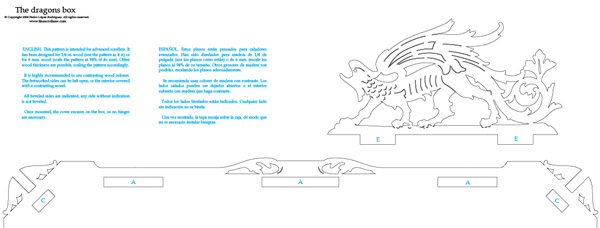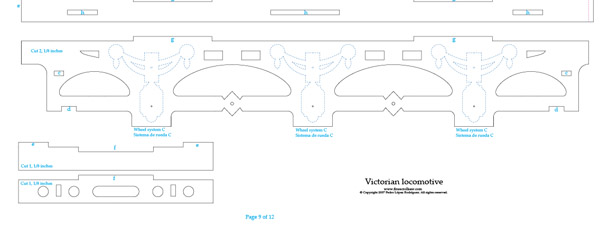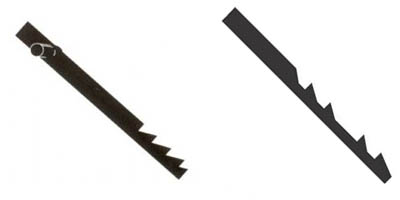
www.finescrollsaw.com
Frequently asked questions
| In this page I will answer the most typical questions I receive about scroll saw and my patterns. Answers do not intend to be exhaustive, only an initial guide so that the beginner can start researching. |
|
What is the quality of your patterns? I make my patterns with the most advanced graphic design techniques presently available. The computer works with a very high precision, so the pieces of the projects fit each other perfectly. This means that if you are precise enough with your scroll saw you will not have to correct, adapt or sand your pieces for them to fit. In fact I started making scroll saw patterns for my own pleasure, because I was quite unhappy with the patterns I had found. Once I have completed a pattern I make a three-dimensional virtual computer model with all the pieces and mount the project just like I would do in real life. If there is any problem with the model, it is easily detected and corrected this way. I then lay the pattern with all the pieces and necessary indications. Finally I print out the patterns. I do not make photocopies, all my patterns are printed in A3 and A4 printers. I am convinced that my patterns are technically the best available. |
|
How do the patterns look like? Can I see some samples? Yes, here you can see two samples of the patterns. Clear lines, perfect symmetries and angles and many indications with letters and numbers to show the position of pieces. Some overlay pieces are shown in position with dotted blue lines.
In the page of patterns for sale you can download a pattern of a fruit basket in pdf format. |
|
I have seen some of your patterns for sale in different websites, where should I buy? What you have seen in other websites is not my patterns. You have seen different patterns of the same design. Some of the designs in my web and in other webs are classical ones, sometimes between 100 and 120 years old. Since these designs are public domain anyone can make editions of these designs for sale. The designs you see in different websites are the same or very similar, however the patterns they sell can be very different. Some companies are simply selling photocopies or simple adaptations of the original old patterns, adding their logo or trademark. Other companies are selling quite good versions of these designs. In my case I fully restore the classical designs to make patterns of remarkable quality, creating a completely new clean pattern out of the old one, with perfect symmetries, slots, tab holes, straight lines, circumferences, everything, using advanced vector graphics software. My patterns are sold only in this web page and no other, and I am not selling anyone else's patterns. Concerning the question ¨where should I buy¨, all I can say is you should buy the one you think is better. If you are interested in one of my patterns but you are not sure whether my pattern will be better than others ask the different sellers the questions you may have until you can decide. I can also send you a sample of the pattern you want by email for you to see how it looks like. |
|
Can I use any wood thickness with your patterns? This is by far the most typical question I receive. Patterns are usually designed for a set of similar wood thickness. This way the pattern can be used by anybody by scaling the pattern appropriately. Similar wood thickness are 1/8 inches, 3 and 4 mm. , or 1/4 inches, 6 or 8 mm. One inch is 25,4 mm. so an easy computation gives that 1/8 inch = 3,175 mm., similar to 3 mm. and quite similar to 4 mm. So, for example, if a pattern is designed for 4 mm. wood, and we want to use 1/8 inches wood, an easy computation shows that the relation between the thickness we want to use and the thickness of the pattern is 3,175 / 4 = 0,79375. We round this number to obtain 0,80. This means that the thickness we want to use is 0,80 times the thickness of the pattern. Consequently, scaling the pattern to 80% we obtain a pattern that can be used with 1/8 inches wood, and everything will fit perfectly. Consequently the model will be 80% the size of the model in the pattern. But this has been previously taken into account during the designing process, so the final size will be a good one. All my patterns have indications about which wood thickness to use and how to scale the pattern to use with the usual wood thickness. Any good copy shop can make your waste copies for the project scaling at a given size. |
|
Why do you have two versions of the pattern for the Eiffel tower and not for the rest? The first version I had was entirely for 3 mm, 4 mm or 1/8 inches wood. Somebody suggested me that 3 mm, 4 mm or 1/8 inches wood was too thin for the sides of the tower and a thicker wood would be better. This is just an opinion but even so I decided to make a second version of the pattern keeping the same height but using double width for the sides of the tower. The result is the second pattern I mention in the order page. If you have an idea of the height you would like your Eiffel tower to be tell me and I will find the best pattern and scale to use to get close to your wishes. |
|
What kind of copyright limitations do I have if I buy one of your patterns? Can I sell the finished projects? The pattern is for your own and exclusive use. You can not sell, rent, give or pass copies of the pattern to anybody, no exceptions. You can make any number of waste copies of the pattern to make your projects. These waste copies have the same limitations as the original pattern. You can make any number of projects from the pattern and you can sell the finished projects freely. |
|
Do you sell digital versions of the patterns, in pdf, dxf or other formats? No, we only send the patterns already printed in paper by ordinary mail or any other courier of your choice. When some time ago I started selling the patterns I sent some by e-mail, in pdf, 8 or 10, and soon afterwards the problems started. Some pages of the patterns must be printed in A3 size. Some people started to send me questions about printers I had never seen, configurations problems, sizes of paper, software compatibility issues, shops where they could print the A3 sheets and complains for the high prices to print A3 sheets in some shops, this service seems to be quite expensive in some places. Some even asked how to print the A3 sheets in two separate A4 to join them afterwards. Due to all these problems and the impossibility to attend all these complicated questions and requests one by one I decided not to send the patterns in digital format anymore, only in printed paper. |
|
¿Where can I buy clock inserts or mechanisms? If you are located in Europe I recommend you http://www.selva.de They have a large collection of all types of clock inserts, mechanisms, chimes, etc, in different sizes and forms. In Spain you can buy some at http://www.ruizrevuelto.com. In the USA there are many shops selling clock inserts and clock mechanisms, for example www.klockit.com, www.klockworks.com and many others (if you want me to include a shop here simply write me). You can also visit Hobbies (www.alwayshobbies.com). They supply customers from the UK and worldwide with scrollsaws, blades, clock insert and movements and more. |
|
Which scroll saw is best? What should I take into account to choose one? Which scroll saw blades do you recommend? ¿Do I need any other tool? The essential condition for a scroll saw is that it can use pinless blades.
On the left we have a pinned blade and on the right a pinless blade. Pinned blades are useful, but they are not adequate for fretwork containing small inner cuts. The reason is that an inner cut requires a pilot hole to put the blade through, but if the blade is pinned, the pilot hole needs to be wider than for a pinless blade, thus making small or fine inner cuts difficult or impossible. Holding a pinned blade is easier than holding a pinless one, so the design of a scroll saw is more simple if it doesn't accept pinless blades, and consequently these scroll saws are normally cheaper. There are some adapters that permit using pinless blades in these scroll saws, but they may not be easy to install in all scroll saws, they may give problems, etc. If you do not want to deal with problems the best is to buy a scroll saw that admits pinless blades. If you have a scroll saw that uses only pinned blades, you can still use it for most inner cuts in a project, for some projects you may even use it for all inner cuts. And when you find a very fine or small inner cut you can turn to a hand saw for it. As important as being able to use pinless blades is to be able to release or tighten the blade in the upper clamp and to tense it so that the process of making all the inner cuts is quick. In particular it is interesting, but not indispensable, not having to use external tools to release or tighten the blade clamp. There are different systems to do this depending on the quality of the scroll saw. The Hegner Multicut 2S scroll saw I own has a system called ¨Quick clamp¨ which is practical and efficient. Other high end scroll saws have similar systems. An important characteristic of a scroll saw is the distance from the blade to the rear frame of the saw, known as its throat. The throat depth determines how large a piece of wood can be cut. Smaller saws have a throat of as little as 12 inches, while very large saws can approach 30 inches. For a good hobbyist an 18 inches scroll saw is an excellent choice. Scroll saw blades can be classified in flat and spiral, and for each of these there are some different types. For beginners I recommend standard flat blades, of low size, when you are more experienced you can explore the uses of other types of blades. If you live in the USA an excellent choice is Flying dutchman blades. To begin with you do not need any other electric tool, however a small drill press is very useful to make the pilot holes for the inner cuts quickly. The drill press I own is the Dremel 200 multifunction, with its vertical support, which is sold separately. |
|
What is the best wood for your projects? Can I use mdf? The wood has to be chosen carefully depending on the project. The best wood you can use is hardwood, two or tree types of hardwood wisely combined will make a project stand out with a subtle combination of colors. However hardwood is significantly more expensive than plywood and only comes in pieces of at most 15 to 20 cm. depending on the type. So if larger pieces are needed you will need to edge glue two or more of these pieces to make larger ones. This can be done and there are some tools you can use to help you but it requires some skills. Plywood doesn't have these limitations, because it is made in pieces of large size. There are many types of plywood, you should use a hard one, the harder the better. For some uses some plywoods are manufactured with one of the sides having a very low quality, of course this plywood is not good for scroll saw projects. A common strong plywood is Baltic birch plywood, just to mention one. I do not like very much mdf for these projects. This material is put together with some glues and other stuff that can melt with the heat of the blade, causing cutting problems. But well I guess some do not have this problem. |
|
I have bought a scroll saw and I am very disappointed, my cuts are disastrous, a total mess, I think this is not for me. To get used to an electric scroll saw I recommend two daily sessions of 20 minutes, that's all. Get some cheap wood and prepare it to cut simple pieces, rectangles, circles, etc, and start scrolling. At the beginning it will certainly be a mess, you will miss the line, the cut will be terrible, etc. The result will be bad but do not desperate, it is normal in the process of learning, you will have started to get the feel of it. Go on for two or three days doing the same. Little by little you will notice that you can control the saw a lot better. I compare it with learning to drive, the first times you drive you are unable to steer the car properly, but after several days you are doing it fine. Once you have some practice and can follow the lines more or less ok, go ahead and make a simple project. The result will be far from perfect, but that's not important, the important is the experience you will be getting from it. Practice also with the finishings, get used to the varnishes, etc. It is better to practice on these learning projects than spoiling a good one later on. Doing this you will notice the progress, it simply requires some time. The essential idea is understaning that doing it very bad at the beginning is completely normal, it is just the first step in the process of learning. |
|
Site Map General: Home - Scroll saw examples - Free patterns 1 - Free patterns 2 - Free patterns 3 - Patterns for sale - Historical books - Shopping recommendations - Hegner review - Questions and answers - Links Scroll saw tutorials: Medusa box - Security box - Egg clock - Eiffel Tower - Sun clock - Washington box This site uses the cookies Doubleclick, Statcounter and Google Adsense to improve the user experience. You can delete these and all other cookies or to block its use from the options menu of your browser. Cookies are harmless text files used by all web sites. |


